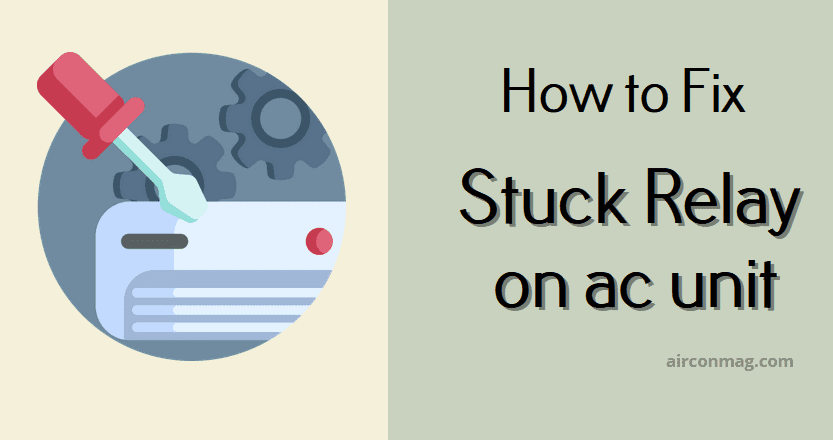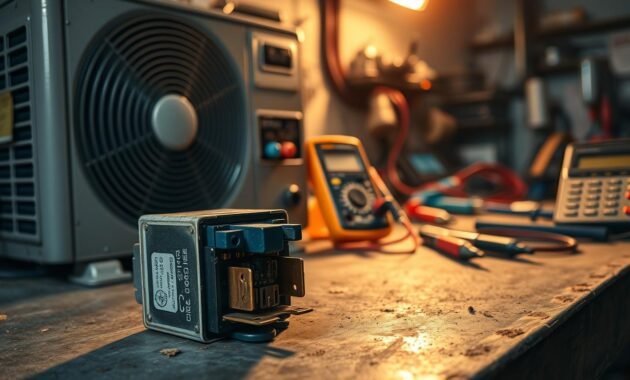Your AC unit suddenly stops working, leaving you sweating and frustrated. A stuck relay can cause cooling nightmares. It disrupts your home’s comfort and might lead to expensive repairs. I’ve seen many homeowners struggle with this problem.
Fixing a stuck relay on an AC unit is easier than you think. With the right knowledge and basic tools, you can solve most relay problems fast. This guide will show you how to fix an AC relay. It will save you time and money on professional service calls.

Understanding AC Relay Function and Purpose
The relay in an AC unit is key to keeping your home cool. It acts like a traffic controller for your air conditioning system. Let’s explore how these components control your home’s cooling.
Air conditioning systems need precise electrical switching to work well. The cost of an ac relay switch might seem small, but it’s vital. It affects your system’s performance and efficiency.
Read also: Bad AC Compressor Symptoms Noise
What is a Compressor Relay?
A compressor relay connects your thermostat to the air conditioner’s compressor. It manages electrical power flow. This ensures your cooling system turns on and off correctly.
- Manages electrical current to the compressor
- Prevents electrical overload
- Protects sensitive AC components
How Relays Control AC Operation
When your home gets too hot, the relay gets a signal from the thermostat. It lets electricity flow to the compressor, starting the cooling cycle. This happens fast, keeping your home cool and comfortable.
Common Relay Types in AC Systems
AC systems use different relays for various tasks. You’ll find start relays, run capacitor relays, and more. Each type has a specific role in managing electrical flow and protecting your AC system.
Knowing about these electrical parts helps you spot problems and make smart choices about maintenance and repairs.
Signs of a Faulty AC Relay
Spotting a bad AC relay switch early can save you money and keep your home cool. I’ve found that catching these issues early helps avoid big repairs and expensive parts.
Here are the key signs to look out for to know if your AC relay switch is bad:
- AC unit won’t turn off completely
- Intermittent cooling performance
- Constant compressor running
- Unusual clicking sounds from the inside ac unit
- Electrical burning smell near the unit
Is your AC unit always on? This might mean the relay is stuck. The relay is key to your system’s power flow. If it goes wrong, your air conditioner might run all the time or not start at all.
Here are some other signs of relay trouble:
- System blowing warm air despite setting
- Frequent circuit breaker tripping
- Inconsistent temperature control
- Higher than normal energy bills
If you see these signs, do a basic check. A multimeter can tell if your AC relay needs to be replaced. This could save you from bigger, more costly repairs.
Read also: What Temperature to Set Air Conditioner in Winter?
Essential Tools and Materials Needed
Fixing a stuck relay on your AC unit needs careful planning and the right tools. Whether you’re a DIY fan or a homeowner trying to fix it, the right tools are key. They can make the repair a success or a hassle.
Read also: How to Fix Window Air Conditioner Compressor Noise
Safety Equipment Requirements
When fixing a stuck relay, safety comes first. It’s important to protect yourself from electrical dangers. This is a must for any AC repair job.
- Insulated electrical gloves
- Safety glasses
- Non-conductive work shoes
- Voltage tester
Diagnostic Tools List
To find and fix a stuck relay, you need special tools. These tools help you spot and solve electrical problems.
| Tool | Purpose | Estimated Cost |
|---|---|---|
| Multimeter | Test electrical continuity and resistance | $20-$50 |
| Wire Strippers | Remove insulation from electrical wires | $10-$25 |
| Screwdriver Set | Disassemble and access relay components | $15-$40 |
Replacement Parts Guide
Having the right parts ready can save you time and trips to the store. When fixing a stuck relay, it’s important to have the correct parts.
- Compatible AC relay for your specific unit model
- Electrical contact cleaner
- Electrical tape
- Wire connectors
Make sure to check your AC unit’s manual or talk to a pro. This ensures you get the right relay for your system. Good tools and parts will help you fix the relay right and avoid future problems.
Safety Precautions Before Starting
When you’re trying to fix an AC unit that won’t turn on, safety comes first. Electrical work can be risky if you don’t follow the right steps. I’ve seen many DIY repairs go wrong because people skipped basic safety steps.
Before you start fixing your AC unit, make sure to follow these important safety tips:
- Always disconnect power at the main circuit breaker
- Use proper electrical safety gear
- Verify power is completely off using a voltage tester
- Wear insulated gloves and safety glasses
Turning off the power is the most important step when fixing an AC unit. Find your home’s electrical panel and switch off the breaker for your air conditioning system. This step removes the risk of electrical shock while you work on the unit.
I suggest wearing rubber-soled shoes and using insulated tools. If you’re not sure about any electrical work, it’s safer to call a professional HVAC technician. Remember, your safety is more important than saving a few dollars on repairs.
- Never work on electrical components with wet hands
- Keep your work area clean and well-lit
- Have a fire extinguisher nearby
- Work with a partner if possible
By following these safety precautions, you’ll avoid electrical hazards while trying to fix your AC unit.
How to Fix a Stuck Relay on AC Unit
Fixing a stuck relay on your AC unit can be tough, but it’s doable. I’ll guide you through each step to fix it safely and right. This will help you find and solve the problem.
First, know why your AC relay might get stuck. It could be electrical problems, wear and tear, or environmental factors.
Power Disconnection Safety
When working with electrical parts, safety is key. Here’s how to safely turn off power:
- Find your home’s main electrical panel
- Turn off the circuit breaker for your AC
- Use a non-contact voltage tester to check for power
Accessing the AC Relay
Finding the relay is easy. It’s usually near the compressor or in the control panel. Look for a small, rectangular or square part with wires.
Diagnostic Testing Methods
To find out if your relay is stuck, you’ll need a multimeter. Here’s how to use it:
- Set your multimeter to continuity or resistance mode
- Take the relay out of its socket
- Check the resistance between the relay’s terminals
| Relay Condition | Multimeter Reading | Action Required |
|---|---|---|
| Normal Relay | 30-120 ohms | No replacement needed |
| Stuck Relay | 0 or infinite ohms | Replace relay immediately |
If your test shows a bad relay, you should replace it. While fixing it yourself can save money, some electrical problems need a pro.
Relay Testing and Diagnosis Methods

Trying to figure out if your AC relay switch is bad can be tricky. But, knowing the right ways to test it can save you a lot of time and money. Let’s explore some practical methods to check your AC relay and see if it needs to be replaced.
Using a multimeter is the best way to test an AC relay. This tool is great for finding electrical problems fast and accurately. Here’s how to test your AC relay step by step:
- Set your multimeter to the resistance (ohms) setting
- Disconnect power to the AC unit completely
- Locate the relay in the AC’s control panel
- Check the relay’s resistance using the multimeter probes
When checking if an AC relay switch is bad, listen for certain signs. A good relay makes a clear clicking sound when it’s turned on. If you don’t hear a click or the sound is weak, it might be failing.
Signs of a bad AC relay include:
- No clicking sound when the AC tries to start
- Inconsistent cooling
- Unusual humming or buzzing from the unit
- Compressor working on and off
Professional HVAC technicians suggest doing these tests with care. If you’re not sure about electrical tests, it’s safer to get a pro to check your AC relay.
Proper Relay Replacement Procedure
Replacing an AC relay might seem hard, but it’s doable on your own. I’ll guide you through the key steps. This way, you can replace it without spending too much on a new switch.
First, get all the tools you need. Then, check the specific needs of your AC unit’s relay.
Choosing the Right Replacement Relay
- Match voltage and amperage rating exactly
- Verify pin configuration matches original relay
- Check compatibility with your AC model
Removal Process
- Disconnect power to the AC unit completely
- Locate the relay in the control panel
- Carefully label all connected wires
- Gently remove the old relay
Installation Steps
Installing the new relay needs care and focus. Here are the main steps to connect it right:
| Step | Action |
|---|---|
| 1 | Align new relay with original mounting position |
| 2 | Reconnect wires exactly as they were labeled |
| 3 | Ensure secure and tight connections |
System Testing After Installation
After putting in the new relay, turn on the power and test your AC. Listen for normal sounds and check if it’s cooling right. If you hear odd noises or it’s not cooling well, check your connections or get help from a pro.
By following these steps, you can replace your AC relay yourself. This might save you a lot of money on repairs. Remember, being patient and careful is key in this process.
Cost Considerations and Professional Services
Understanding the cost of fixing an AC unit not turning on is key. I’ve outlined the expenses you might face during this repair.
Fixing a stuck relay doesn’t have to be expensive. DIY fans can fix it for as little as $20. Professional services usually cost between $100 and $300.
Breakdown of Possible Costs
| Repair Option | Cost Range | Complexity |
|---|---|---|
| DIY Relay Replacement | $20 – $50 | Low |
| Professional Repair | $100 – $300 | High |
| Relay Component | $10 – $50 | Component Only |
When choosing between DIY and professional service, consider a few things:
- Your technical skill level
- Electrical system complexity
- Warranty considerations
- Time availability
If you’re good with basic electrical work and have the right tools, DIY can save money. Professional HVAC technicians have the skills to handle complex issues that homeowners might not.
Remember, while DIY repairs are cheaper, wrong installation can cause more damage. If unsure, it’s best to get a professional.
Preventive Maintenance Tips
Keeping your AC unit in top shape is key to avoiding expensive repairs. This is true, even for issues like a blown fuse in an AC unit. Regular maintenance can save you a lot of time and money.
To keep your AC system running well, I’ll share some important preventive tips. These can help your unit last longer and avoid electrical problems.
- Clean or replace air filters every 1-3 months
- Clear debris around outdoor AC unit regularly
- Check electrical connections for signs of wear
- Inspect refrigerant levels annually
- Schedule professional maintenance twice a year
Preventing a blown fuse in an AC unit is always better than fixing it. Regular maintenance lets you catch problems early, before they get big.
| Maintenance Task | Frequency | Benefit |
|---|---|---|
| Air Filter Replacement | Every 1-3 months | Improves air quality and system efficiency |
| Outdoor Unit Cleaning | Quarterly | Prevents airflow blockage and system strain |
| Professional Inspection | Bi-annually | Identifies possible electrical issues early |
By following these maintenance tips, you’ll lower the chance of unexpected breakdowns. You’ll also make your AC system last longer. Remember, a little preventive care can make a big difference in keeping your home cool and comfy.
When to Call a Professional
Even the best DIY fans know when to stop. Some AC unit problems are too big for home fixes. Knowing when to call a pro can prevent dangers and save money.

If your AC won’t turn off or you can’t fix it, it’s time for a pro. Here are situations where you need an expert:
Emergency Situations
- Electrical sparking or burning smells near the AC unit
- Complete system failure with no cooling
- Unusual loud noises or grinding sounds
- Potential refrigerant leaks
Complex Electrical Issues
Electrical problems need special skills. If you face these issues, call a pro:
- Repeated circuit breaker tripping
- Wiring damage or exposed electrical components
- Persistent relay or compressor malfunctions
- Complex diagnostic challenges beyond basic troubleshooting
Warranty Considerations
Many AC makers won’t honor warranties if you fix it yourself. Pros can:
- Maintain your system’s warranty
- Provide certified diagnostic reports
- Ensure proper repair documentation
- Offer professional-grade replacement parts
Always put your safety and investment first. If unsure, let a certified HVAC pro handle it.
Conclusion
I’ve shown you how to fix a stuck relay on your AC unit. Knowing how to do this can save you money and avoid sudden breakdowns in the summer. It might seem hard at first, but with the right steps, you can handle this AC problem easily.
Learning to fix a stuck relay lets homeowners manage their cooling system better. You now know how to spot symptoms, test, and replace the relay. The main thing is to be patient, observe carefully, and follow safety rules while fixing it.
While you can fix some things yourself, it’s okay to call a pro if you’re not sure. Your home’s comfort and safety are most important. Regular upkeep and quick fixes can stop small problems from becoming big, costly repairs.
By learning these skills, you’re not just fixing an AC part. You’re becoming a more informed and active homeowner. Your new knowledge will keep your cooling system working well for many years.


